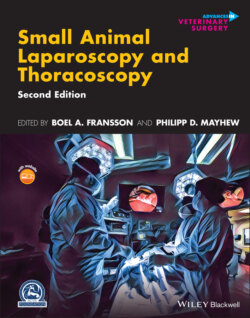Читать книгу Small Animal Laparoscopy and Thoracoscopy - Группа авторов - Страница 129
Safety of Monopolar Electrosurgery
ОглавлениеApproximately 40 000 human patients sustain electrosurgical‐related injuries each year. Up to 70% of electrosurgical burns go undetected at the time of laparoscopic surgery, often because the active electrode is outside of the surgeons' field of view [8]. Three different types of coupling injuries can occur: direct coupling, indirect coupling, and capacitive coupling [4,9–11]. Direct coupling is the result of an electrically conductive object in close proximity to the target tissue. It occurs when the active electrode is activated before contact with the tissues resulting in energy transmission to the unwanted electrically conductive object, which can manifest as a burn (Figure 5.6). Indirect coupling results from a discontinuity in the insulating coating of the active electrode. If this occurs, the current is drawn toward a neighboring electrically conductive object. Because of the lack of output on the target tissue, power settings are often increased, intensifying the misdirected current (Figure 5.7). These insulation breaks are often small and not visible to the naked eye. These small breaks in insulation are dangerous because large current densities are concentrated at these small discontinuities in insulation. Capacitive coupling results from a build‐up of current between two conducting substances that are separated by an insulating substance. When the charge exceeds the insulating capacity, it can spark across the insulator to the other conducting substance, resulting in thermal injury. Capacitive coupling injuries occur most often with the use of “hybrid” cannula systems, or those that use both conductive (metal) and insulating (plastic) materials. All metal cannulas are less likely to result in this type of coupling injury because stray current is dispersed over a larger surface area. The extent of coupling injuries depends on the magnitude of the current applied.
Figure 5.6 Direct coupling occurs when the active electrode is in close proximity to another metal instrument and activation of the electrosurgical device occurs, transmitting current to the metal instrument and ultimately the adjacent structures. ESU, electrosurgical unit.
Source: From Dubiel et al.[1].
Figure 5.7 Indirect coupling or insulation failure occurs when there is damage to the insulation of the active electrode. This allows for stray current to be discharged and may result in injury to neighboring tissues. ESU, electrosurgical unit.
Source: From Dubiel et al. [1].
